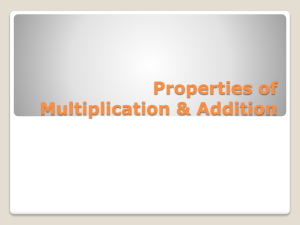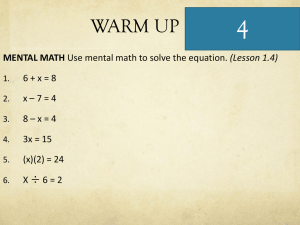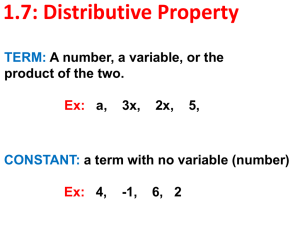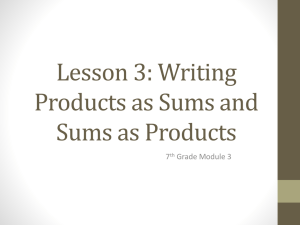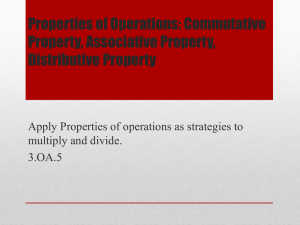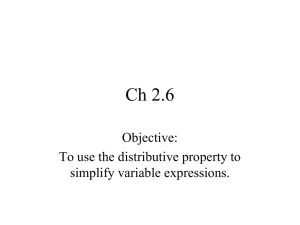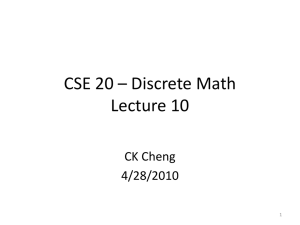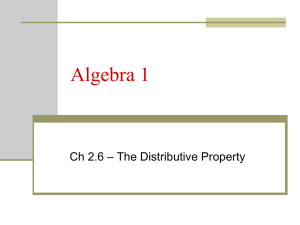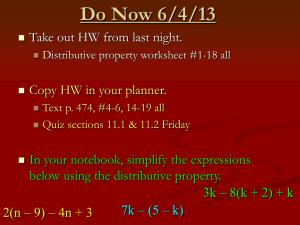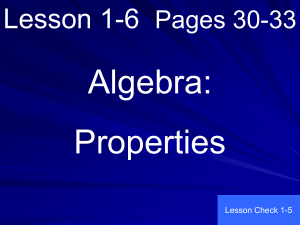Model of The Distributive Property
advertisement
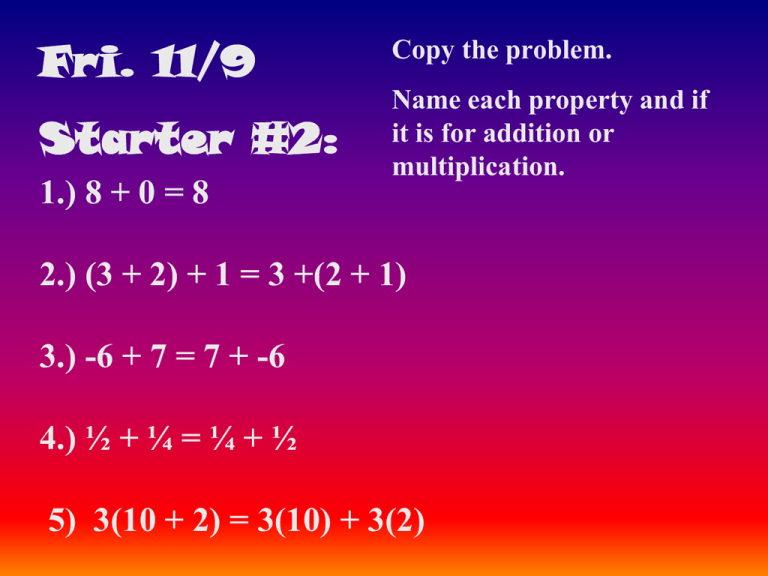
Fri. 11/9 Copy the problem. Starter #2: Name each property and if it is for addition or multiplication. 1.) 8 + 0 = 8 2.) (3 + 2) + 1 = 3 +(2 + 1) 3.) -6 + 7 = 7 + -6 4.) ½ + ¼ = ¼ + ½ 5) 3(10 + 2) = 3(10) + 3(2) USING GENERIC RECTANLGES TO MODEL THE DISTRIBUTIVE PROPERTY! Learning Targets #7: I can explain and use the MODEL for the Distributive Property B: 1 2 3 A: 1 2 3 I have these questions: 7.AF1.3 Learning Targets #8: I can explain and use the Distributive Property B: 1 2 3 A: 1 2 3 I have these questions: 7.AF •The Distributive Property is used constantly in class for mental Math. •That means it is used to solve multiplication problems in your head. •Just watch! •Let’s say we want to multiply 53 x 6 •Doing 53 x 6 in your head can be a challenge. •So let’s break it apart to make it easier. •We know that: 53 50 3 (50 6) (3 6) (300) (18) 318 So 53 6 318 •Let’s try more mental Math! 16 8 24 7 (10 8) (6 8) (20 7) (4 7) (80) (48) 128 (140) (28) 168 So 16 8 128 So 24 7 168 THIS WORKS BECAUSE OF THE DISTRIBUTIVE PROPERTY!!! Model of The Distributive Property •A generic rectangle can be used to model the Distributive Property. •The Distributive Property wants you to distribute what is on the outside of the parenthesis to the inside of the parenthesis. Model of The Distributive Property Let’s say we want to do the following problem using mental Math. 3 19 3(10 + 9) 10 + 9 3 3(10) + 3(9) = 3(10) + 3(9) 10 + 9 3 30 + 27 = 30 + 27 = 57 Model of The Distributive Property Now let’s try a problem using a 4( x 5) 4(x + 5) variable. x + 5 4 4(x) + 4(5) = 4(x) + 4(5) x + 5 4 4x + 20 = 4x + 20 Model of The Distributive Property A generic rectangle can be used to model the Distributive Property. The Distributive Property wants you to distribute what is on the outside of the parenthesis to the inside of the parenthesis. x + 4 3(x + 4) 3 3(x)+ 3(4) = 3x + 12 y –7 5(y –7) 5 5(y) – 5(7) = 5y– 35 Simplify using the distributive property. 1) 5(x 3) 4) 4(3 y) 5 x 53 43 4 y 5x 15 12 4y 2) 6(y 7) 6 y 6 7 6y 42 5) 10(x 7) 10 x 10 7 10x 70 3) 3(m 8) 3 m 38 3m 24 6) 4(k 2) 4k 42 4k 8 Simplify using the distributive property. 1) 4(x 7) 4) 7(8 x) 4 x 47 78 7 x 4x 28 56 7x 2) y(y 3) y y y3 y 3y 2 3) x(2x 9) x 2x x 9 2x 9x 2 5) x(a b c) xa xb xc ax bx cx 6) 4(3 m k) 43 4 m 4 k 12 4m 4k THE END!!! Take out your Learning Targets LT #7 Model of The Distributive Property A generic rectangle can be used to model the Distributive Property. The Distributive Property wants you to distribute (give away) what is on the outside of the parenthesis to the terms on the inside of the parentheses. x + 4 3(x + 4) 3(x)3 + 3(4) = 3x + 12 y –7 5(y –7) 5(y) 5– 5(7) = 5y– 35 LT #8 The Distributive property is very useful for mental math! a(b + c) = ab + ac Example: 16 8 (10 8) (6 8) (80) (48) 128 4(x+5) 6(x-2) = 4(x) + 4(5) = 6(x) – 6(2) = 4x + 20 = 6x – 12 -3(x+7) = -3(x) + -3(7) = -3x+ (-21) Name___________ November 9, 2012 Period___ The Distributive Property and Review Worksheet

